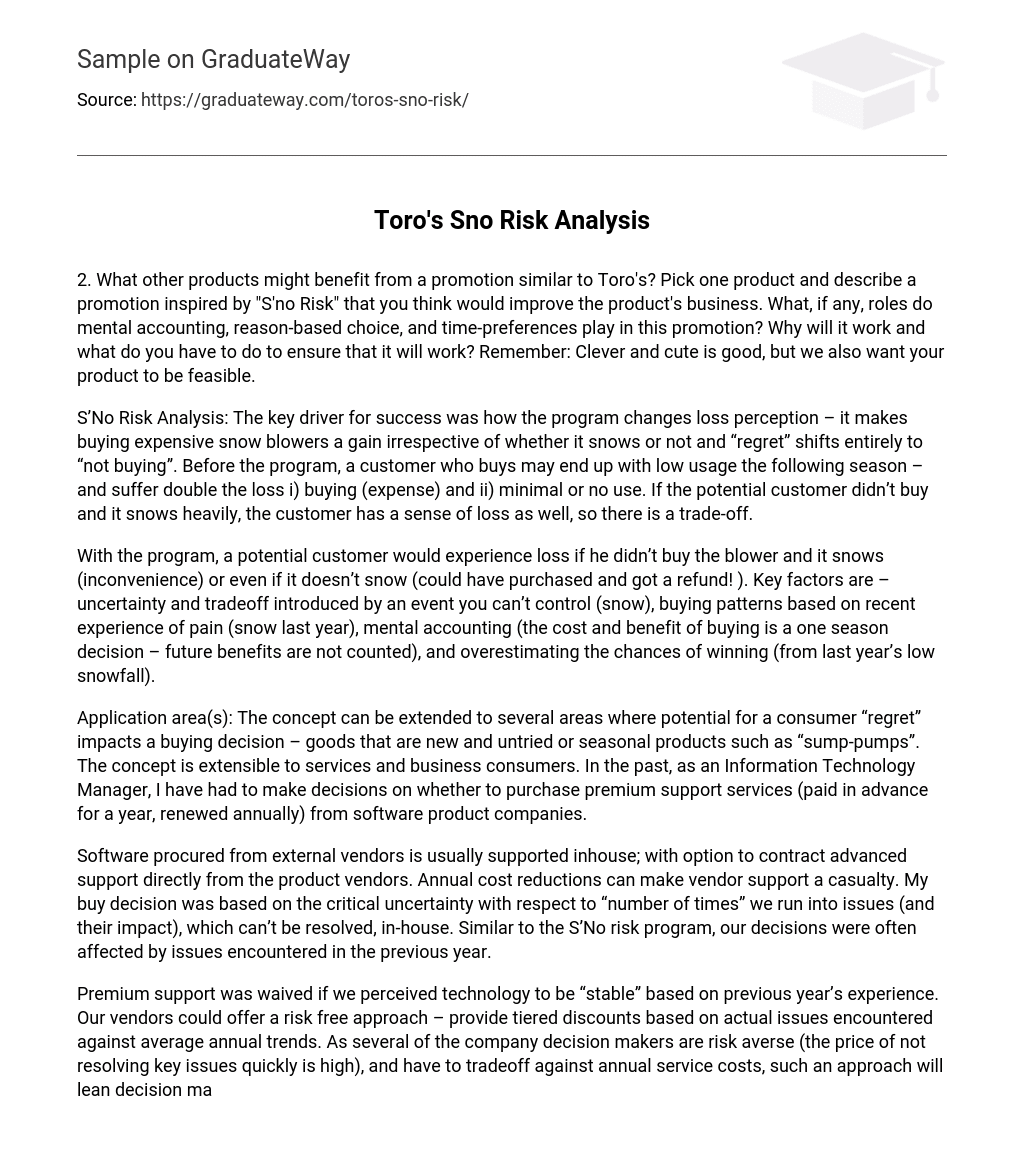2. What other products might benefit from a promotion similar to Toro’s? Pick one product and describe a promotion inspired by “S’no Risk” that you think would improve the product’s business. What, if any, roles do mental accounting, reason-based choice, and time-preferences play in this promotion? Why will it work and what do you have to do to ensure that it will work? Remember: Clever and cute is good, but we also want your product to be feasible.
S’No Risk Analysis: The key driver for success was how the program changes loss perception – it makes buying expensive snow blowers a gain irrespective of whether it snows or not and “regret” shifts entirely to “not buying”. Before the program, a customer who buys may end up with low usage the following season – and suffer double the loss i) buying (expense) and ii) minimal or no use. If the potential customer didn’t buy and it snows heavily, the customer has a sense of loss as well, so there is a trade-off.
With the program, a potential customer would experience loss if he didn’t buy the blower and it snows (inconvenience) or even if it doesn’t snow (could have purchased and got a refund! ). Key factors are – uncertainty and tradeoff introduced by an event you can’t control (snow), buying patterns based on recent experience of pain (snow last year), mental accounting (the cost and benefit of buying is a one season decision – future benefits are not counted), and overestimating the chances of winning (from last year’s low snowfall).
Application area(s): The concept can be extended to several areas where potential for a consumer “regret” impacts a buying decision – goods that are new and untried or seasonal products such as “sump-pumps”. The concept is extensible to services and business consumers. In the past, as an Information Technology Manager, I have had to make decisions on whether to purchase premium support services (paid in advance for a year, renewed annually) from software product companies.
Software procured from external vendors is usually supported inhouse; with option to contract advanced support directly from the product vendors. Annual cost reductions can make vendor support a casualty. My buy decision was based on the critical uncertainty with respect to “number of times” we run into issues (and their impact), which can’t be resolved, in-house. Similar to the S’No risk program, our decisions were often affected by issues encountered in the previous year.
Premium support was waived if we perceived technology to be “stable” based on previous year’s experience. Our vendors could offer a risk free approach – provide tiered discounts based on actual issues encountered against average annual trends. As several of the company decision makers are risk averse (the price of not resolving key issues quickly is high), and have to tradeoff against annual service costs, such an approach will lean decision makers in favor of renewing annual support.
The time dimension of the issue (one year) will affect the mental accounting (costs vs. benefit in one year). Most of us will reason that our risks are covered (low) and that we have a good chance to gain from such a transaction, particularly after good, risk free years. If I were the vendor, I would be cautious around how much discount to offer and the discount tiers to offer based on historical trends. IT buyers will typically buy such services nevertheless in case of a product upgrade (usually every three years) or if there were too many issues in the past year.
Further, for vendors, the strategy may be money making over a longer time horizon than year to year. Client’s sense of loss (and dissatisfaction) will be high if such an option is not offered every year. Therefore, as a vendor, it may make sense to offer such services in a 3-5 year locked down contract, with payments and refunds still being annual. A solution packaged as above will make the decision risk free (and easy to defend) for IT decision makers while assuring repeat services business for the software vendors.





